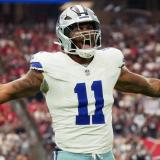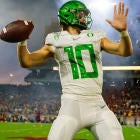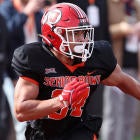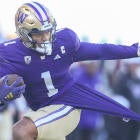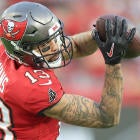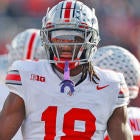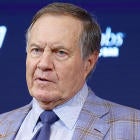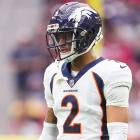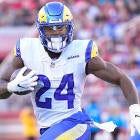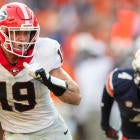At this point in the proceedings, with just one week left in the college football regular season, these quarterbacks are who they are. LSU's Joe Burrow has been one of the best stories in college football while Oregon's Justin Herbert has been the most frustrating. And with Tua Tagovailoa's 2019 campaign over, a once-deep quarterbacks class is now full of questions. Should Jacob Eason and Jake Fromm return to school? What about Jordan Love? And how much of Lincoln Riley's offense explains Jalen Hurts' success at Oklahoma?
These answers will go a long way in determining how the 2020 NFL Draft unfold. For now, let's get to how some of these quarterbacks fared this week.
Justin Herbert, Oregon
We've been hinting at it for weeks but we're finally there: Justin Herbert isn't a first-round quarterback. He has all the physical tools -- he's 6-foot-6, is extremely athletic and can throw the ball out of the stadium -- but his decision making is suspect at best, and his otherworldly physical skills can not overcome that poor decision making.
Yes, Herbert was without Mycah Pittman and Jaylon Redd on Saturday night, but he still has one of the best offensive lines in the country, not to mention a running game that averages 5.0 yards per carry. And more importantly, the No. 6 Ducks were facing a 5-5 Sun Devils team that had lost four straight and was starting a true freshman quarterback. There was no excuse for Oregon losing this game, or for Herbert playing the way he did.
Things started well -- Herbert showed off his NFL arm on his very first throw of the night, rolling left and throwing a laser back over the middle of the field, this is why folks want to love his game. And we saw glimpses of Herbert at his best against the Sun Devils but we saw a lot more of why he's so polarizing -- and in our minds, not worth a first-round pick.
With time to step and throw, Herbert misses just inside on an out route and what would've set up third-and-short instead makes it third and 19. And you might point out, 'Hey, he just missed his target by a foot or two at most.' And we would agree, but this wasn't an isolated incident, it's become a theme for most of the season. Also: These are the exact throws Herbert will be expected to make with regularity at the next level.
Facing third and 10 midway through the third quarter, Herbert again had time to step and throw in the pocket. But he throws off his back foot and airmails his intended target on an out route. Wide receiver Josh Delgado was open but Herbert missed him badly, though it wouldn't be his worst throw of the night.
Same story. Little bit of interior pressure (phantom pressure) forces Herbert’s entire plan to go out the window. Cannot do it with this quarterback, guys. Cannot do it. pic.twitter.com/ZfHFq3dJIT
— Travis Wingfield (@WingfieldNFL) November 24, 2019
A drive later, Herbert shakes off a pass rusher in the pocket, but panics and forces a throw that should've been intercepted. Things went downhill from there. The next drive, which started the fourth quarter, Herbert makes another inexplicable throw, this time to the other team:
He’s 4/13 with 69 yards and a pick against the blitz tonight. When Dolphins fans say you have to build the Oline before you can get the QB, that actually applies with Herbert. pic.twitter.com/5spyMQfAni
— Travis Wingfield (@WingfieldNFL) November 24, 2019
After the turnover, ESPN flashed this graphic:
- Herbert vs. no blitz: 6 of 8 for 58 yards, 0 TDs, 0 INTs
- Herbert vs. blitz: 4 of 13 for 69 yards, 0 TDs, 1 INT
Those numbers would soon be updated because on his very next throw he was intercepted again.
Bad snap had this play off from the start but boy oh boy that’s an awful decision from Justin Herbert. pic.twitter.com/GkCdlYddtt
— Rob Paul (@RobPaulNFL) November 24, 2019
It was a low snap, but Herbert doesn't set himself, throws off his back foot, and throws well wide of his intended target, a target it's worth noting was never open. Those turnovers accounted for 10 Arizona State points and the Sun Devils led 24-7 midway through the final quarter.
After an Oregon rushing score, Herbert did toss a nice back-shoulder touchdown to Johnny Johnson to cut the lead to 24-21. (Herbert has thrown at least two other touchdowns this season with this play call; he and tight end Jacob Breeland connected against Montana earlier in the year.) But Herbert should've been intercepted again on the next series; under no pressure and facing an eight-man zone look, he forced another ball downfield.
He finished 20 of 36 for 304 yards with 2 touchdowns and 2 interceptions. His 55.6 completion percentage was the low mark of the season, and this was easily his worst game in 2019. With Tagovailoa sidelined, this was Herbert's time to convince skeptics that he was legit. Instead, he has raised more questions than he's answered after solid performances against USC and Arizona in previous weeks.
It only takes one team to fall in love with Herbert's potential and make him a first-round pick, but you'd be hard-pressed to convince us, based on what we've seen the last two seasons, that he's a franchise quarterback.
Jalen Hurts, Oklahoma
Jalen Hurts and the Sooners scored on their first three possessions to take a 21-0 lead over TCU, but the offense sputtered through the final three quarters to hold on for win No. 10. Hurts finished just 11 of 21 for a 145 yards with two touchdowns and a terrible interception but he rushed 28 times for 173 yards and two more scores.
And Hurts' dual-threat ability is what makes him such a great college player. But does that translate to the NFL? Because while he's an amazing runner, he doesn't have Lamar Jackson's athleticism. This means he's going to take a lot of hits from bigger, stronger and faster NFL players. And while Hurts is good for the occasional wow throw, his first instinct is to run, especially when his first read isn't there; his eyes drop, he leaves the pocket and usually looks to make plays with his feet.
Again, that's a perfectly suitable strategy in college but it's a short-lived one in the NFL. Hurts has also struggled with deep-ball accuracy at times this season, including Saturday night. He missed a wide-open Charleston Rambo in the end zone on the first drive, and he overthrew an open CeeDee Lamb in the second half for what could've have been another score.
On the Sooners' third touchdown of the game, Hurts makes a nice back-shoulder throw to Lamb near the pylon, but on the play before, he missed Lamb on a slant -- Lamb had beaten his defender but Hurts threw behind him.
On the drive before, Hurts made his best throw of the night, allowing tight end Brayden Willis to high-point the pass before somehow making his way to the end zone:
🚨TOUCHDOWN🚨
— Sooner Gridiron (@soonergridiron) November 24, 2019
What a catch and extension by Brayden Willis.#OUDNA | #BoomerSooner pic.twitter.com/MLAaKI3JWl
For much of the second half, the Sooners relied on the run game, led by Hurts and Kennedy Brooks. Partly because they were successful but also because the passing game was out of sorts. TCU regularly rushed just three and dropped eight, and Hurts never really had an answer for it. Early in the final quarter with Oklahoma leading 24-17, Hurts attempted a simple quick out in the red zone. The ball was deflected and almost intercepted. A play later, Hurts threw again, this time misfiring on a slant route, and TCU picked him off, returning it the length of the field for a touchdown.
This is going to get interesting... @TCUFootball's Vernon Scott with the 98-yard pick six. This game is far from over. #CollegeGameDay
— Black and Gold Nation (@B_GNation1) November 24, 2019
( Courtesy of @CFBONFOX )pic.twitter.com/u1K4XIuZAC
On the next series, Hurts relied on his legs to get Oklahoma back into the red zone … where he turned the ball over again, this time fumbling as he went to the ground.
Oklahoma wisely ran the ball on its final 10 plays to escape with the victory. Hurts is undoubtedly an intriguing prospect but he's a one-read passer who would much prefer to run. Again, that works well in college football but is not an optimal strategy at the next level.
Joe Burrow, LSU
There's not a lot to say about Burrow at this point. The same adjectives we used to describe him a month ago remain applicable, perhaps more so: Efficient, accurate at every level, sneaky athletic, savvy in the pocket and incredibly smart. Yes, Arkansas is a dumpster fire, and yes, Burrow was out of the game late in the third quarter, but he did nothing to change our opinion that a) he's the best quarterback in college football and b) he'll be the first player drafted in April.
Burrow finished 23 of 28 for 327 yards, with three touchdowns and no turnovers. His 82.1 completion percentage? It was the fourth time this season he completed at least 80 percent of his throws. And unlike Herbert, who struggles when his first read isn't there, and often panics as a consequence, Burrow is almost casual in the pocket and he goes through his progressions. And when he needs an outlet, Clyde Edwards-Helaire has become his security blanket; after just 11 receptions last season, and 10 receptions through the first six games of 2019, Edwards-Helaire has hauled in 29 passes the last five weeks.
But Burrow isn't a dink-and-dunker; he wants to air it out and we saw that on the very first drive, where he showed off his ability to deftly move up in the pocket, then step into the throw, and while it was slightly underthrown, he had to like the matchup of Ja'Marr Chase vs. anybody in a one-on-one situation. Chase won, LSU touchdown.
Joe Burrow vs Arkansas
— Travis Wingfield (@WingfieldNFL) November 24, 2019
First drive ends in a long TD, but it was back-to-back under-throws on 50-yard heaves. pic.twitter.com/GHb97I6gsH
In the second quarter, Burrow did a nice job of feeling the pressure off his right, sliding slightly to his left to buy time, waiting for Justin Jefferson to come uncovered out of the slot and walk into the end zone.
Joe Burrow with an easy TD to Justin Jefferson. The refs absolutely hate the fun the LSU offensive players are having with their celebrations. pic.twitter.com/aD5fiRUqLk
— Rob Paul (@RobPaulNFL) November 24, 2019
Burrow now has 4,014 passing yards on the season. He's only the fourth SEC quarterback to surpass 4,000 yards, joining Tim Couch, Johnny Manziel and Chad Kelly. And it sure feels like he's going to have the best NFL career of the group.
Jordan Love, Utah State
Jordan Love, like Herbert and Burrow above, looked a lot like the guy we've seen all season. There's no denying that Utah State's lack of offensive playmakers has hampered Love's ability to consistently make plays; four of their best players from a year ago are no longer with the team and Love plays like someone who knows that he has to do everything.
It hasn't gone well. Yes, there are the flashes of brilliance we see every game, but there are too many miscues to count, which often lead to turnovers, and more importantly, raise questions about his NFL readiness. Love tossed another interception on Saturday night against 20th-ranked Boise State. That was his 15th interception of the season, which leads all FBS quarterbacks.
Like Burrow against Arkansas, Love was also out of the game by the fourth quarter. But unlike Burrow, it was because Utah State was getting its doors blown off.
Love's second series of the game was a highlight reel of why he's so electric, and why NFL teams are so intrigued. He made all three of these throws on one drive.
Jordan Love vs Boise State
— Travis Wingfield (@WingfieldNFL) November 24, 2019
Consistently makes jaw dropping plays. The live arm, the escape-ability; he stands to make a lot of bad play calls right. pic.twitter.com/j2O4Vpukbe
He is so, so good at feathering deep balls to his receivers, especially when he's on the run. In fact, Love may do this better than any other passer in the country. Then, a few plays later, following a Curtis Weaver sack, another raindrop from Love:
Good lord pic.twitter.com/zXsQkKSeeV
— Travis Wingfield (@WingfieldNFL) November 24, 2019
And finally, the drive ends with an "only my receiver can catch this" throw in the end zone that culminates with Caleb Repp's ridiculous one-handed grab. This is peak Love, and if we saw more of this version he'd be a no-brainer top-15 pick. But these plays have been hard to come by this season, especially after a breakout 2018 campaign.
On Love's very next drive, he throws a mind-numbing pick-six on a quick out route. Given his arm strength, it's maddening to watch, especially since he's done this several times this season in similar situations. It's all the more maddening when you watch him complete much more difficult passes -- NFL passes -- with almost no effort.
Two words describe Love: Arm talent. But there's so much more to sort through when trying to predict his NFL future. He is undeniably talented but he needs another 2-3 years of experience before he's ready to be a starter at the next level. The question is: Does he get that experience by returning to Utah State in 2020 or on an NFL roster?
Jacob Eason, Washington
You could talk us into a scenario where it makes for Jordan Love to return for his senior season. You could also convince us that he'd be better served on an NFL roster, learning on the job. When the conversation turns to Jacob Eason, we're convinced he needs to return to Washington. He hasn't played a lot of football in recent years -- he lost his job to Jake Fromm early in 2017, left Georgia for Washington, and didn't play in 2018. Eason has played 11 games this season and the pressure of performing at a high level appears to be wearing on him.
He had 10 touchdowns and two interceptions through the first four games. In the six games since, he has 11 touchdowns and six interceptions. Over the first eight games, only once did Eason complete fewer than 60 percent of his throws. He's now down it twice in his last three outings.
The good: Eason is one of the most accurate short and intermediate passers and he excels at throwing slants. Not only is he accurate, but he puts the ball in a position where his receiver can maximize yards after catch. This is often referred to as a quarterback's ability to throw a runner's ball. He's done it week after week, all season.
The bad: Things start to break down when Eason is pressured. We saw this against Utah, where Washington dominated the first half and imploded in the second half. We saw it much of Saturday night against Colorado, where the Buffs spent much of the game in the backfield, harassing Eason, and forcing him into bad decisions, including a first-quarter interception that was wholly a result of getting pressured. Eason also lacks touch on deep throws even though his arm strength rivals Justin Herbert's. Unlike Jordan Love, who can drop a 50-yard bomb into a bucket, Eason struggles with touch on these types of throws, either allowing the underneath defender to make a play on the ball or overthrowing everyone on the field.
Eason is an intriguing prospect with incredible physical tools, but he just doesn't look like he's ready for the NFL.








